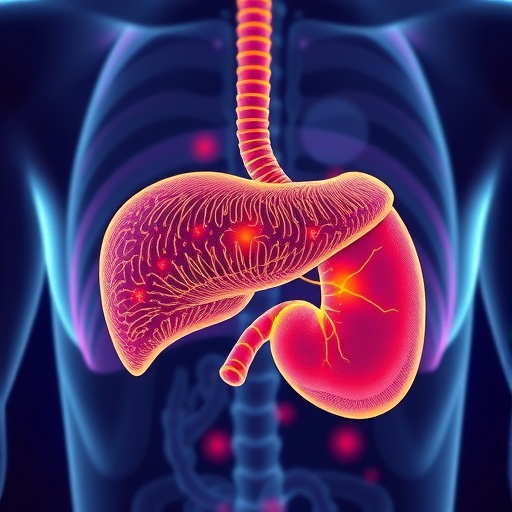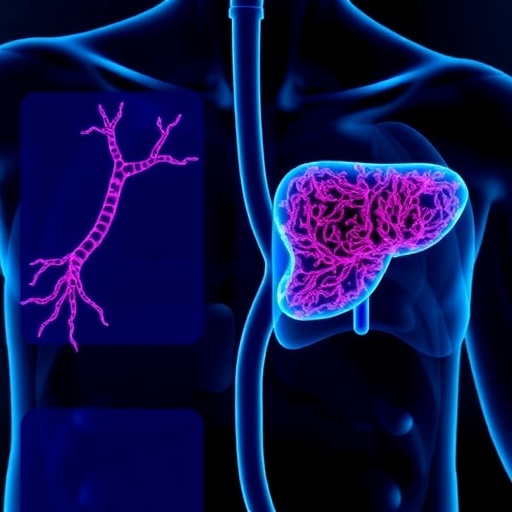In a pioneering advance intersecting oncology and artificial intelligence, researchers have unveiled a machine learning model capable of accurately forecasting five-year overall survival in patients with hepatocellular carcinoma (HCC). This breakthrough arrives at a critical juncture for liver cancer prognosis, where traditional methods have struggled to balance precision with the practical constraints of limited clinical data. By harnessing sophisticated algorithms on a modest dataset, this study signals the potential for AI-driven tools to revolutionize personalized cancer care and outcomes.
Hepatocellular carcinoma represents one of the most deadly malignancies worldwide, often presenting insidiously with rapid metastasis and high recurrence rates. Early detection and prognostication remain fraught with challenges due to the tumor’s biological complexity and diverse clinical presentations. Against this backdrop, the imperative to develop reliable predictive models capable of guiding treatment decisions and patient management is more urgent than ever. The new study boldly confronts this issue by leveraging machine learning to tease out meaningful survival patterns from limited patient data.
The researchers enrolled 76 newly diagnosed HCC patients between September 2018 and July 2019, methodically collecting comprehensive pathological and survival-related factors prior to any treatment intervention. These patients, followed over periods ranging from one to 67 months, were classified into survivors and nonsurvivors based on a five-year outcome benchmark. This cohort, while small, formed the backbone for developing multiple predictive models using diverse machine learning approaches including logistic regression (LR), support vector machines (SVM), decision tree classification (DTC), random forests (RF), and extreme gradient boosting (XGBoost).
.adsslot_cGPTQsYRvB{ width:728px !important; height:90px !important; }
@media (max-width:1199px) { .adsslot_cGPTQsYRvB{ width:468px !important; height:60px !important; } }
@media (max-width:767px) { .adsslot_cGPTQsYRvB{ width:320px !important; height:50px !important; } }
ADVERTISEMENT
Feature selection was a pivotal step in the analysis, refining an initial set to 22 clinically and biologically relevant variables. This curated variable set encompassed a range of tumor characteristics, laboratory markers, and cellular phenotypes such as maximum tumor diameter, the presence or absence of distant metastasis, CNLC staging, albumin levels, age, red blood cell count, and circulating tumor cell subtypes among others. Importantly, these factors are known to influence tumor biology and patient prognosis, yet integrating them effectively into prognostic modeling remained a challenge until now.
Across the five models tested, the SVM algorithm emerged as the unequivocal leader, exhibiting the highest accuracy (98.7%), F1 score (0.988), recall (1.000), and an impressive area under the curve (AUC) of 0.971. These metrics underscore the SVM’s exceptional ability to discriminate between long-term survivors and nonsurvivors within the dataset. The model’s robustness was further corroborated through rigorous internal and external validations, emphasizing its potential reliability and clinical applicability even in scenarios of constrained sample size.
The implication of this work transcends mere prediction. By identifying and weighting critical risk factors, the SVM model offers a mechanistic lens into the complex interplay driving HCC progression and survival. Variables such as PD-L1 negative circulating tumor cells, vascular cancer thrombus, tumor staging, and various immune cell clusters were particularly influential. This granular insight could enable clinicians to stratify patients more precisely and tailor therapeutic interventions accordingly, potentially improving survival outcomes through targeted management strategies.
Moreover, the study’s methodology exemplifies the feasibility of deploying advanced machine learning in oncology despite the prevalent obstacle of limited datasets, which is a common issue in clinical research. By judicious feature selection and leveraging algorithm strengths, the researchers have mitigated common pitfalls such as overfitting and model instability, setting a precedent for future AI-driven diagnostic and prognostic tools in cancer research.
Further reinforcing the clinical value, the use of decision curve analysis validated the net benefit gained by employing the SVM model over other conventional methods. This translates to more informed and effective clinical decisions, balancing benefits against potential harms in patient care. In practice, this could mean earlier identification of high-risk patients who may benefit from intensified surveillance or adjunctive therapies.
The study also underscores the importance of integrating novel cellular biomarkers alongside traditional clinical parameters. Incorporation of circulating tumor cell subpopulations and specific immune clusters capitalizes on the evolving understanding of tumor microenvironment dynamics. The predictive power of these biomarkers within the SVM model suggests their critical role not only as prognostic indicators but potentially as therapeutic targets.
While the sample size remains relatively small, the rigorous validation procedures employed by the research team bolster confidence in the model’s generalizability. The dual internal and external validation approach reflects a commitment to replicability and sets a robust framework for future studies to build upon. The demonstrated stability across diverse patient subgroups highlights the broad applicability within the HCC population.
Looking ahead, this machine learning-based prognostic model paves the way for integrating AI into routine cancer care pathways. Its success suggests that even with limited data, predictive analytics can yield actionable insights. As healthcare increasingly embraces precision medicine, models like this will be indispensable for unlocking personalized treatment plans and resource optimization.
In summary, this study represents a significant leap forward in HCC prognostics by marrying advanced data science with clinical oncology. The deployment of an SVM model trained on small-sample data transcends conventional challenges, offering a powerful tool to accurately predict long-term survival. This progression underscores the transformative potential of artificial intelligence in reshaping cancer prognosis, guiding treatment decisions, and ultimately improving patient outcomes.
The integration of complex variables concerning tumor biology and immune response within the model not only enhances prediction accuracy but also provides a deeper understanding of underlying disease mechanisms. Such insights may fuel further research into targeted therapies and precision oncology approaches tailored to individual risk profiles.
Furthermore, the study exemplifies how multidisciplinary collaboration—combining expertise in medical oncology, pathology, and machine learning—can overcome traditional limitations in cancer research. This holistic approach is likely to inspire subsequent innovations across oncologic prognostication and treatment algorithms.
As the oncology community grapples with increasing patient complexity and heterogeneity, tools like this small-sample machine learning model offer a beacon of clarity. With continued refinement and integration into clinical workflows, predictive models of this caliber can significantly enhance outcomes for patients grappling with this formidable disease.
Ultimately, the study marks a promising step towards an era where data-driven, personalized predictions augment clinical intuition, ushering in improved standards of care for hepatocellular carcinoma patients globally.
Subject of Research: Prediction of 5-year overall survival in hepatocellular carcinoma using machine learning models on small-sample clinical data.
Article Title: Development and validation of a small-sample machine learning model to predict 5–year overall survival in patients with hepatocellular carcinoma.
Article References:
Jiang, T., Liu, X., He, W. et al. Development and validation of a small-sample machine learning model to predict 5–year overall survival in patients with hepatocellular carcinoma. BMC Cancer 25, 1040 (2025). https://doi.org/10.1186/s12885-025-14425-0
Image Credits: Scienmag.com
DOI: https://doi.org/10.1186/s12885-025-14425-0
Tags: AI-driven liver cancer prognosisalgorithms for cancer survival analysischallenges in liver cancer prognosisclinical data limitations in cancer researchearly detection of hepatocellular carcinomahepatocellular carcinoma survival predictioninnovative approaches to cancer treatment decisionsmachine learning in oncologymetastatic liver cancer complicationspatient management in oncologypersonalized cancer care toolspredictive models for liver cancer





